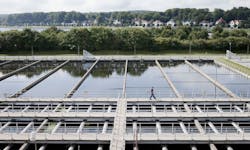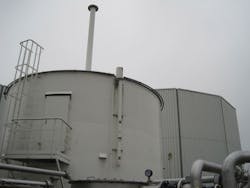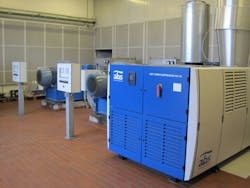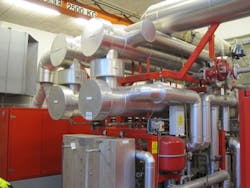Self Sufficient Wastewater Treatment - Sharing Denmark's Sustainability Blueprint
Denmark has undertaken a massive overhaul of its wastewater treatment over the last decade, creating a blueprint for sustainability. Marselisborg is the jewel in the crown, which last year generated over 50 percent more energy that it needed. WWi visited the facility and find out more.
By William Steel
Tucked away a stone’s throw southeast of the center of Denmark’s second city, Aarhus, is the Marselisborg wastewater treatment plant (WWTP).
An unassuming facility, there is a noticeable absence of smell in the surrounding port air and it is modest in size; little hint therefore that the plant processes waste for some 220,000 Aarhusians.
Perhaps unknown to most of those residents too is that members of the water treatment industry travel from around the world with the express purpose of visiting Marselisborg WWTP.
“Most people come to see the solutions enabling energy self-sufficiency achieved here,” Per Overgaard Pedersen, chief engineer at the company operating the plant, Aarhus Water, tells WWi during a tour of the facility.
“Last year we recorded power self-sufficiency equivalent to 153 percent, meaning that the plant’s power production was 53 percent higher than consumption. In our industry, this is quite unusual – not many treatment plants achieve such a level of performance. Elsewhere in Denmark, the figure is typically around 80 percent.”
What’s more, the plant also contributes heat to the local district heating system.
“In terms of heat plus power production at Marselisborg, we produced 168 percent of our needs last year,” adds Pedersen.
The figures are more impressive yet considering that Marselisborg processes 12 million cubic meters of wastewater per year.
Attaining such levels of performance has resulted from a ‘masterplan’ geared toward optimising efficiency and increasing self-sufficiency; goals that were sought through reducing energy consumption and increasing energy production.
Implementation of a first phase in the plan began in 2006 with consolidation of several smaller WWTPs around Aarhus: from fourteen plants to just four today, with Marselisborg WWTP remaining the largest.
Commenting on the motivation for centralisation, Pedersen says: “It’s more energy- and cost-efficient to treat wastewater at larger plants. And operating fewer but larger plants also decreases operation and maintenance costs.”
“After this came efforts to reduce energy consumption and optimise energy efficiency at every stage of the treatment process,” he adds.
The developments were undertaken over ten years and have only recently concluded, but the outcome is something quite remarkable – nothing short of a state of the art blueprint for sustainable wastewater treatment.
Cutting down on energy consumption
A foundation to increased efficiency at Marselisborg was established via optimisation of its processes through implementation of a SCADA (Supervisory control and data acquisition) control system.
Representing an investment of around €400,000, the system produced a reduction in annual electricity consumption of around 700,000 kWh, corresponding to an annual saving of €61,000.
Pedersen notes: “Optimisation with SCADA, including online control of ammonium and phosphor, and frequency controllers on some equipment, has brought many benefits and actually some of the largest savings in terms of power consumption. It had a payback time of two to three years.”
Another important refinement in plant operations came with replacement of blowers for the aeration system: replacing three HV turbo blowers, which had served the aeration system for years, with a highly efficient ABS HST compressor.
The change resulted in a reduction in power consumption of 300,000 kWh per year and annual savings of some €26,000. The new compressor is far friendlier to the environment too, enabling a CO2 reduction to the tune of 153 tons per year.
According to Pedersen a critical component in Marselisborg’s transition to an energy efficient system was introduction of a side-stream Anammox (anaerobic ammonium oxidation) sludge liquor treatment process.
The system – using characteristic red bacteria - removes ammonia from sludge liquor under conditions more efficient than conventional methods: requiring less aeration and consequently less electricity.
Pedersen highlights: “An additional benefit of this system was a yearly saving in the wastewater tax payment equivalent to €80,000 per year [as a result of] a 2 mg/l reduction of total nitrogen in outlet from the plant.”
Installed in late 2014 the Anammox system cost €400,000, and produces an annual saving in electricity of 50,000 kWh per year.
Elsewhere, the latest addition has been installation of a final decanter centrifuge. The unit dewaters waste sludge from digesters, creating dry matter, in preparation for its being transported away from Marselisborg for delivery as fertiliser.
The decanter was delivered by Alfa-Laval A/S, a Danish equipment supplier, and achieves cuts in energy consumption of approximately 50,000 kWh/year.
Altogether, energy saving measures at the plant led to an overall reduction in power consumption of approximately 1 GWh per year, an amount equivalent to approximately 25 percent in total savings.
“Our annual WWTP power consumption through 2016 was 3.15GWh; we estimate that the plant processed wastewater through 2016 with an energy consumption rate of 0.28 kWh/m3,” adds Pedersen.
Upping the energy production
Enabling the plant to go beyond energy neutrality, the second string to Marselisborg’s bow presents in the form of its capacity to produce energy.
On-site are three anaerobic digester tanks, each with 2000 cubic meters of sludge capacity. As it is digested, the sludge produces biogas that is used in the production of heat and power in an adjacent building.
Here too, Aarhus Water sought refinement over two phases: a first phase replaced three old-fashioned gas engines with two high efficiency, 250kW combined heat & power (CHP) units at a cost of €1.2 million; while a second phase saw an old engine with a capacity 313kW replaced with a new engine of 355kW.
The CHP units achieved electricity generation in the region of 4.8 million kWh through 2016, while also enabling a substantial CO2 reduction.
After powering the plant, surplus electricity is sold to the national power grid; contributions that are compensated for through conventional financial mechanisms.
Pedersen explains: “We’re paid per kilowatt hour produced at a rate comparable to what wind power, and other green energy, producers are paid here in Denmark. Of course, this payment acts as a source of revenue, so reduces our payback time on investments. But in the future we can see ourselves operating without such subsidies.”
Altogether through 2016, Marselisborg WWTP produced 4.8 GWh and consumed 3.15GWh of electricity – leading to a net electricity surplus of 53 percent. Meanwhile, surplus heat is directed towards Aarhus district heating. Through 2016, sale of 2.6 GWh in surplus heat brought in €55,000.
energy neutral water cycle
Ultimately, Aarhus Water’s goal is an energy neutral water cycle in which WWTP energy production is able to offset the energy consumption of operations within its catchment area, including: groundwater extraction, water treatment, water and wastewater transport as well as wastewater treatment at plants themselves.
It’s a goal within reach for the Marselisborg WWTP and its catchment area, which covers a majority of Aarhus city center.
“In 2014/15, we were close to self-sufficiency for heat and power combined; around 90 percent. The forecast for 2016 is 107 percent. We’re still working through some of the data but we’re optimistic of having reached self-sufficiency,” says Pedersen.
The developments undertaken by Aarhus Water at the plant haven’t been cheap but the benefits are clear and present in Marselisborg WWTP having reduced its OPEX by between three to four percent.
As Pedersen remarks: “In total we invested approximately €3 million in energy optimisation projects. But when taking into account the sale of surplus heat and power - which amounts to a little over €326,000 annually – alongside all the savings made, reduction in consumption of €206,000, reduced wastewater taxes of €80,000 and so on, we’re looking at an overall saving of €612,000, and payback time for all investments of approximately five years.”
Still a work in progress
Aarhus Water is not yet finished with development of wastewater treatment facilities around Aarhus.
For one, the process of centralisation will continue. “Within the next ten years, we would like to reduce further from four to two plants. We’re also looking to establish an entirely new, larger, Marselisborg WWTP to serve approximately 500,000 people.”
“There’s no new space for expansion here,” he said in reference in the existing facility. “But a new plant offers the chance for us to take the best of what we’ve developed and learnt so far and it in a fresh context.”
“There will also be a chance to look at the state of the art of technology, both in wastewater treatment, resource recovery, sludge treatment and so on.”
Pedersen described that new avenues under development include options for production of different types of fertilisers, wastewater heat recovery prior to discharge into Aarhus Bay, and methods for phosphor recovery.
On the latter, Pedersen says: “We want to establish large scale phosphorus recovery tests as it’s something we’re interested in integrating into the future Marselisborg plant.”
Pilot tests are already underway at neighboring Åby WWTP, but by August this year Marselisborg will become home to the largest phosphorus recovery system in Denmark.
“We’re aiming for phosphor recovery up to 30 to 50 percent in 2017-18 at Marselisborg WWTP,” says Pedersen.
A blueprint to follow
The Danish state has a lengthy history of working to foster the export of its thriving green technologies industry. And while Denmark is synonymous with wind power, its water sector is world-class, producing technologies and solutions – many installed beyond Marselisborg – that Denmark is keen to showcase.
Such intention is reflected in state-supported apparatus such as State of Green – a platform for exhibiting Denmark’s clean technology sector to foreign actors.
“We actually just recently prepared a white paper with State of Green on water resource recovery and energy efficiency in wastewater treatment,” says Pedersen, who described how sharing the experiences of Marselisborg is a significant part of his role. “We work to support the establishment of other projects, often in far larger plants than we have here. We help by sending Danish consultants and contractors to consult on the opportunities and by working with the Danish government to help export water technologies. It’s been a successful venture.”
He continued: “We believe if we’re providing services and technology transfer to other water companies, then we’ll also bring some solutions back home to see how we can utilize them within our own systems.”
What is happening at Marselisborg is by no means an isolated case; it’s part of a trend seen across Denmark, and indeed in other countries too.
Pedersen observes: “Wastewater technologies are developing at a rapid pace. The tendency is going from viewing wastewater as waste, to as a valuable resource to be recovered, whilst also minimising energy used in treatment.”
Nevertheless, Marselisborg exhibits how at a single plant multiple solutions geared to this ambition can work holistically and in harmony.
“Without doubt there is global interest in the solutions on display here,” said Pedersen, who last year alone welcomed visitors from France, Serbia, all Scandinavian nations, and from further afield including, Argentina, the United States, Saudi Arabia, South Africa and India.
“I believe there’s a valuable blueprint in Marselisborg that others are keen to see installed and working. And we’re keen to assist in that effort.”
William Steel is a freelance writer for WWi magazine, based in Denmark.
More Water & WasteWater International Archives Issue Articles




